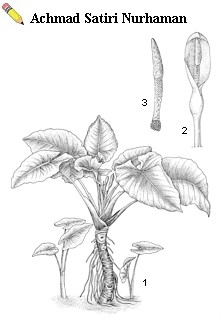Record Number
2380
PROSEA Handbook Number
12(3): Medicinal and poisonous plants 3
Taxon
Alocasia macrorrhizos (L.) G. Don
This article should be read together with the article on the genus: Alocasia in the Handbook volume indicated above in this database.
This article should be read together with the article on the genus: Alocasia in the Handbook volume indicated above in this database.
Protologue
Sweet, Hort. Brit., ed. 3: 631 (1839).
Synonyms
Alocasia indica (Lour.) Spach (1846).
Vernacular Names
Giant taro, giant alocasia, elephant ear (En). Grande tayove (Fr). Indonesia: bira (general), sente (Javanese), mael (Timor). Malaysia: birah negeri, keladi sebaring. Papua New Guinea: abir, pia, via. Philippines: biga (general), bira (Ilokano), badiang (Tagalog, Bisaya). Burma (Myanmar): pein-mohawaya. Cambodia: k'da:t haôra:. Laos: kaph'uk. Thailand: kradaat (Bangkok), kradaat dam (Kanchanaburi), horaa (Songkhla, Yala). Vietnam: r[as]y, r[as]y [aw]n.
Distribution
It is unclear where Alocasia macrorrhizos is indigenous. It does not appear to be wild in Malesia, but has been introduced and is often naturalized in the Malesian region and Oceania, and elsewhere in the tropics. Perhaps it should be considered a cultigen.
Uses
Boiled stems are used as a laxative, chopped-up roots and leaves as a rubefacient, and juice from the petiole against cough. In Papua New Guinea, young leaves and sap are used externally to treat headache, and leaves cooked in coconut milk are eaten to treat sexual insufficiency. In Thailand, the rhizome is applied to snakebites and wounds. The rhizome is a source of starch or flour. Alocasia macrorrhizos is often planted as an ornamental.
Observations
A very large herb up to 400 cm tall, with erect or decumbent stem; leaves not peltate, over 80 cm x 60 cm, petiole up to 130 cm long, not mottled; spadix 13—20 cm long. Alocasia macrorrhizos occurs along roadsides, in waste places and gardens, mostly in wet locations at low and medium altitudes.
Image
 | Alocasia macrorrhizos (L.) G. Don - 1, plant habit; 2, spathe and spadix; 3, spadix |
Selected Sources
[47]Argall, M.E., Bradbury, J.H. & Shaw, D.C., 1994. Amino-acid sequence of a trypsin/chymotrypsin inhibitor from giant taro (Alocasia macrorrhiza). Biochimica et Biophysica Acta 1204(2): 189—194.
[91]Bhatt, S.K. & Saxena, V.K., 1980. Antifungal activity of seed extracts of Alocasia indica. Indian Drugs 17(7): 210—211.
[121]Burkill, I.H., 1966. A dictionary of the economic products of the Malay Peninsula. Revised reprint. 2 volumes. Ministry of Agriculture and Co- operatives, Kuala Lumpur, Malaysia. Vol. 1 (A—H) pp. 1—1240, Vol. 2 (I— Z) pp. 1241—2444.
[245]Flach, M. & Rumawas, F. (Editors), 1996. Plant Resources of South-East Asia No 9. Plants yielding non-seed carbohydrates. Backhuys Publishers, Leiden, the Netherlands. 239 pp.
[325]Hay, A., 1998. The genus Alocasia (Araceae - Colocasieae) in West Malesia and Sulawesi. Gardens' Bulletin Singapore 50: 221—334.
[327]Hay, A., 1999. The genus Alocasia (Araceae - Colocasieae) in the Philippines. Gardens' Bulletin Singapore 51: 1—41.
[331]Hegnauer, R., 1962—1997. Chemotaxonomie der Pflanzen [Chemotaxonomy of plants]. 11 volumes. Birkhäuser Verlag, Basel, Switzerland.
[347]Holdsworth, D.K., 1977. Medicinal plants of Papua New Guinea. Technical Paper No 175. South Pacific Commission, Noumea, New Caledonia. 123 pp.
[445]Kamboj, S.S., Shangary, S., Singh, J., Kamboj, K.K. & Sandhu, R.S., 1995. New lymphocyte stimulating monocot lectins from family Araceae. Immunological Investigations 24(5): 845—855.
[566]Lin, T.J. et al., 1998. Calcium oxalate is the main toxic component in clinical presentations of Alocasia macrorrhiza (L.) Schott & Endl. poisonings. Veterinary and Human Toxicology 40(2): 93—95.
[760]Quisumbing, E., 1978. Medicinal plants of the Philippines. Katha Publishing Co., Quezon City, the Philippines. 1262 pp.
[1020]Xu, H.-X. et al., 1996. Screening of traditional medicines for their inhibitory activity against HIV-1 protease. Phytotherapy Research 10: 207—210.
[91]Bhatt, S.K. & Saxena, V.K., 1980. Antifungal activity of seed extracts of Alocasia indica. Indian Drugs 17(7): 210—211.
[121]Burkill, I.H., 1966. A dictionary of the economic products of the Malay Peninsula. Revised reprint. 2 volumes. Ministry of Agriculture and Co- operatives, Kuala Lumpur, Malaysia. Vol. 1 (A—H) pp. 1—1240, Vol. 2 (I— Z) pp. 1241—2444.
[245]Flach, M. & Rumawas, F. (Editors), 1996. Plant Resources of South-East Asia No 9. Plants yielding non-seed carbohydrates. Backhuys Publishers, Leiden, the Netherlands. 239 pp.
[325]Hay, A., 1998. The genus Alocasia (Araceae - Colocasieae) in West Malesia and Sulawesi. Gardens' Bulletin Singapore 50: 221—334.
[327]Hay, A., 1999. The genus Alocasia (Araceae - Colocasieae) in the Philippines. Gardens' Bulletin Singapore 51: 1—41.
[331]Hegnauer, R., 1962—1997. Chemotaxonomie der Pflanzen [Chemotaxonomy of plants]. 11 volumes. Birkhäuser Verlag, Basel, Switzerland.
[347]Holdsworth, D.K., 1977. Medicinal plants of Papua New Guinea. Technical Paper No 175. South Pacific Commission, Noumea, New Caledonia. 123 pp.
[445]Kamboj, S.S., Shangary, S., Singh, J., Kamboj, K.K. & Sandhu, R.S., 1995. New lymphocyte stimulating monocot lectins from family Araceae. Immunological Investigations 24(5): 845—855.
[566]Lin, T.J. et al., 1998. Calcium oxalate is the main toxic component in clinical presentations of Alocasia macrorrhiza (L.) Schott & Endl. poisonings. Veterinary and Human Toxicology 40(2): 93—95.
[760]Quisumbing, E., 1978. Medicinal plants of the Philippines. Katha Publishing Co., Quezon City, the Philippines. 1262 pp.
[1020]Xu, H.-X. et al., 1996. Screening of traditional medicines for their inhibitory activity against HIV-1 protease. Phytotherapy Research 10: 207—210.
Author(s)
Hadi Sutarno
Correct Citation of this Article
Sutarno, H., 2003. Alocasia macrorrhizos (L.) G. Don. In: Lemmens, R.H.M.J. and Bunyapraphatsara, N. (Editors): Plant Resources of South-East Asia No 12(3): Medicinal and poisonous plants 3. PROSEA Foundation, Bogor, Indonesia. Database record: prota4u.org/prosea

All texts are licensed under a Creative Commons Attribution-Noncommercial-Share Alike 3.0 Netherlands License
This license does not include the illustrations (Maps,drawings,pictures); these remain all under copyright.